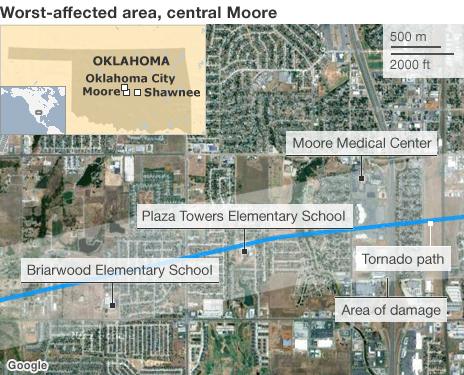Oklahoma tornado: Search for survivors nears end
- Published
Nick Childs reports on the continuing rescue effort in Moore, Oklahoma
Rescue workers are combing the ruins left by the gigantic tornado that killed two dozen people, including nine children, in Oklahoma on Monday.
Officials say the search for survivors is nearly over as efforts turn towards recovery.
Gary Bird, fire chief of the badly hit Moore suburb, said he was "98% sure" there were no more survivors or bodies to recover from the rubble.
The storm has meanwhile been upgraded to the most powerful level of twister.
Packing winds of at least 200mph (320km/h), the tornado razed a swathe of Moore, a suburb of Oklahoma City.
Oklahoma Governor Mary Fallin said the death toll could rise above 24 as some bodies may have been taken directly to funeral homes.
The body count was revised down from 51 after the state medical examiner said some victims may have been counted twice in the confusion.
According to Mr Bird, no survivors or bodies have been found since Monday night.
Jerry Lojka, a spokesman for the Oklahoma emergency services, told Reuters news agency on Wednesday that search-and-rescue dog teams would continue their work "to be sure nothing is overlooked", but he added: "There's going to be more of a transition to recovery."
Emergency crews have had trouble navigating the devastated neighbourhoods because there were no street signs remaining. Some used mobile phones and GPS to navigate.
Jacob Lyles recorded his rescue of two children from the rubble of Plaza Towers Elementary school in Moore
Craig Fugate, of the Federal Emergency Management Agency (Fema), told MSNBC: "Right now it's about getting people a place to stay that have lost their homes. So we're going to start going neighbourhood to neighbourhood and talking to people and seeing what they're going to need."
The National Weather Service (NWS) has upgraded the tornado to EF-5, the most powerful type on the Fujita scale. It uses the word "incredible'' to describe the force of such a storm.
The NWS said the twister's path was 17 miles long and 1.3 miles wide.
For about 45 minutes on Monday afternoon, the storm battered the suburb of about 55,000 people.
Emergency workers pulled more than 100 survivors from the rubble of homes, schools and a hospital, while 237 people were known to have been injured.
-
 I tried to be the best dad I could be
00.58
I tried to be the best dad I could be
00.58
-
 How I pulled children from rubble
02.38
How I pulled children from rubble
02.38
-
 I haven't taken a breath yet
03.02
I haven't taken a breath yet
03.02
-
 "Tornado's power caught on camera"
00.47
"Tornado's power caught on camera"
00.47
-
 Cellar opened to reveal 'apocalypse'
01.12
Cellar opened to reveal 'apocalypse'
01.12
-
 'Open hearts and homes'
01.12
'Open hearts and homes'
01.12
-
 We thought we were dead
00.51
We thought we were dead
00.51
-
 Why they call it 'Tornado Alley'
01.12
Why they call it 'Tornado Alley'
01.12
-
 TV station evacuated on air
03.22
TV station evacuated on air
03.22
-
 'Massive tornado coming towards us'
02.07
'Massive tornado coming towards us'
02.07
-
 'I was pretty lucky I suppose'
00.45
'I was pretty lucky I suppose'
00.45
-
 Collapsed bowling alley amid rubble
00.45
Collapsed bowling alley amid rubble
00.45
Seven of the nine children killed in the tornado died at Plaza Towers Elementary, where the storm ripped off the roof and knocked down walls as students and teachers cowered in hallways and bathrooms.
That primary school and one other hit by the storm, Briarwood Elementary, did not have safe rooms that protect against tornadoes, said Albert Ashwood, of the Oklahoma Department of Emergency Management.
More than 100 schools in Oklahoma had been provided with state-funded safe rooms, he said, but not those two.
The mayor of Moore, Glenn Lewis, told CNN on Wednesday that he would press for a law requiring storm shelters or safe rooms in new houses "as soon as I can".
Residents were given 16 minutes' warning before the tornado touched down - officials said such advisories were usually issued eight to 10 minutes ahead of a twister.
Oklahoma's insurance commissioner told Reuters news agency the cost of the storm would exceed that of the 2011 tornado in Joplin, Missouri, that killed 158 people. He said the Joplin twister caused $3bn (£2bn) in damage.
US President Barack Obama has declared a major disaster in Oklahoma and ordered federal authorities to join in the search efforts.
Homeland Security Secretary Janet Napolitano is due in Oklahoma on Wednesday to back rescue and recovery efforts.
"The people of Moore should know that their country will remain on the ground there for them, beside them as long as it takes for their homes and schools to rebuild," Mr Obama said from the White House.
Heavy-lifting equipment was deployed under bright floodlights as the operation continued overnight and throughout Tuesday.
Rescuers braved the danger of electrocution and fire from downed power lines, as well as ruptured natural gas lines.
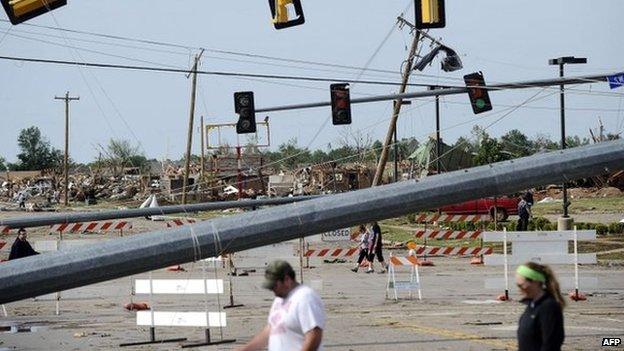
The tornado brought down trees, power lines and traffic lights, and overturned vehicles.
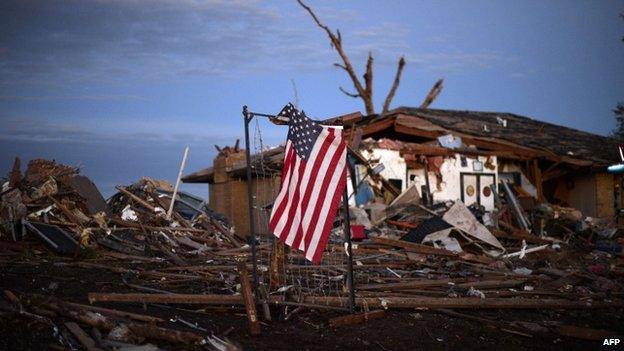
Homes in the suburb of Moore were either flattened by the high winds or heavily damaged.
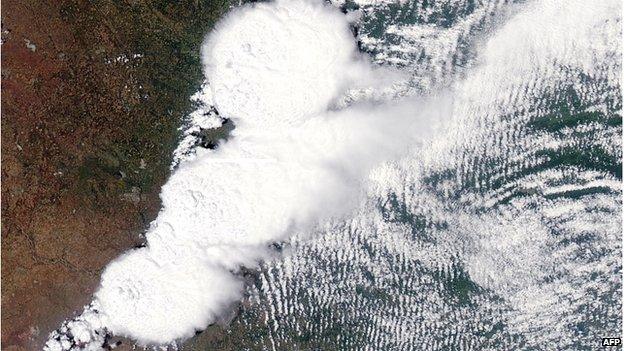
An image released by Nasa shows the storm system in the minutes before it produced the devastating tornado.
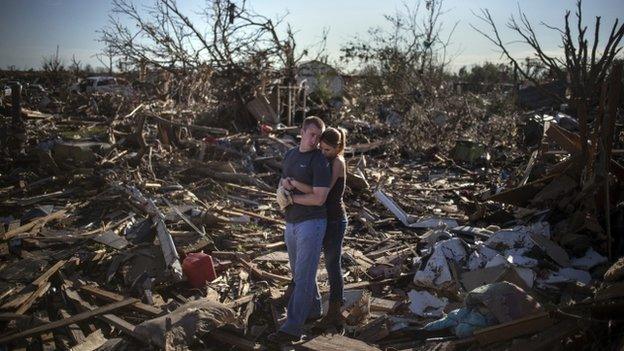
Many residents are having to cope with the distress of returning to destroyed homes as they try to retrieve lost possessions. Danielle Stephan holds her boyfriend Thomas Layton at what remains of a relative's home.
